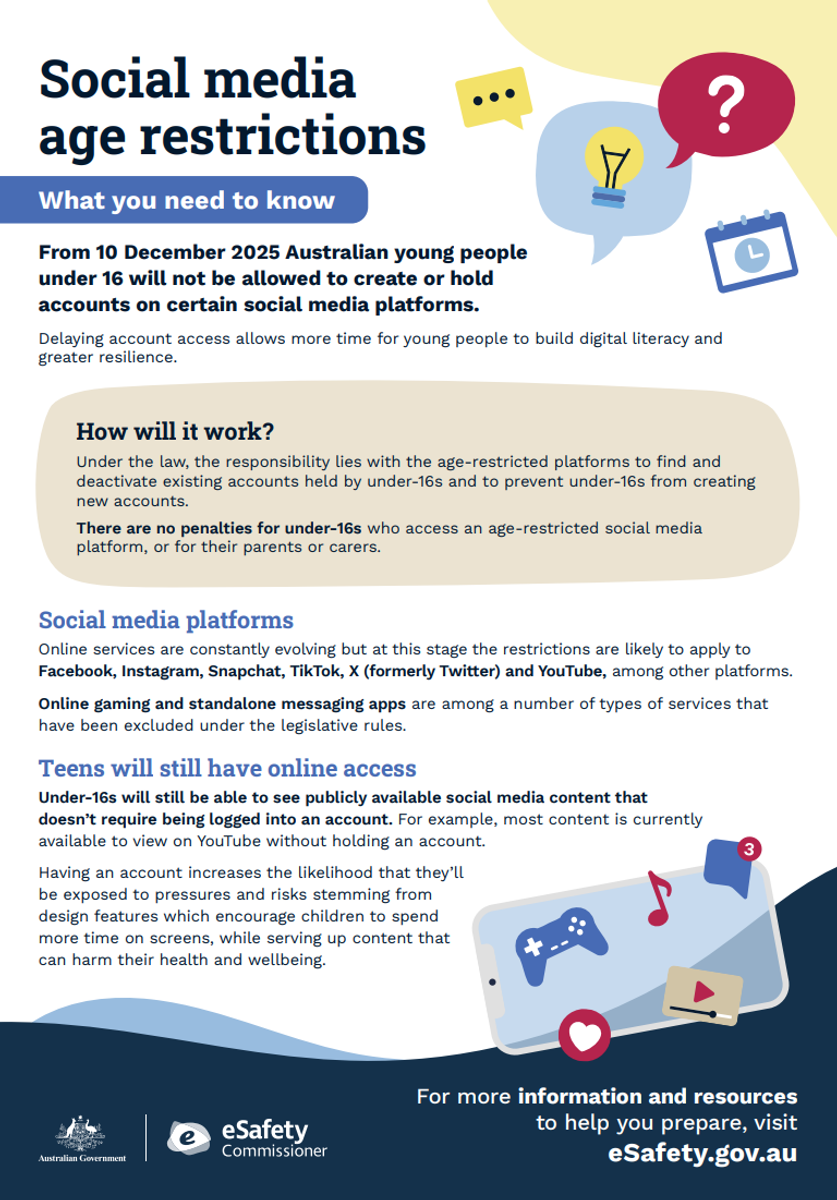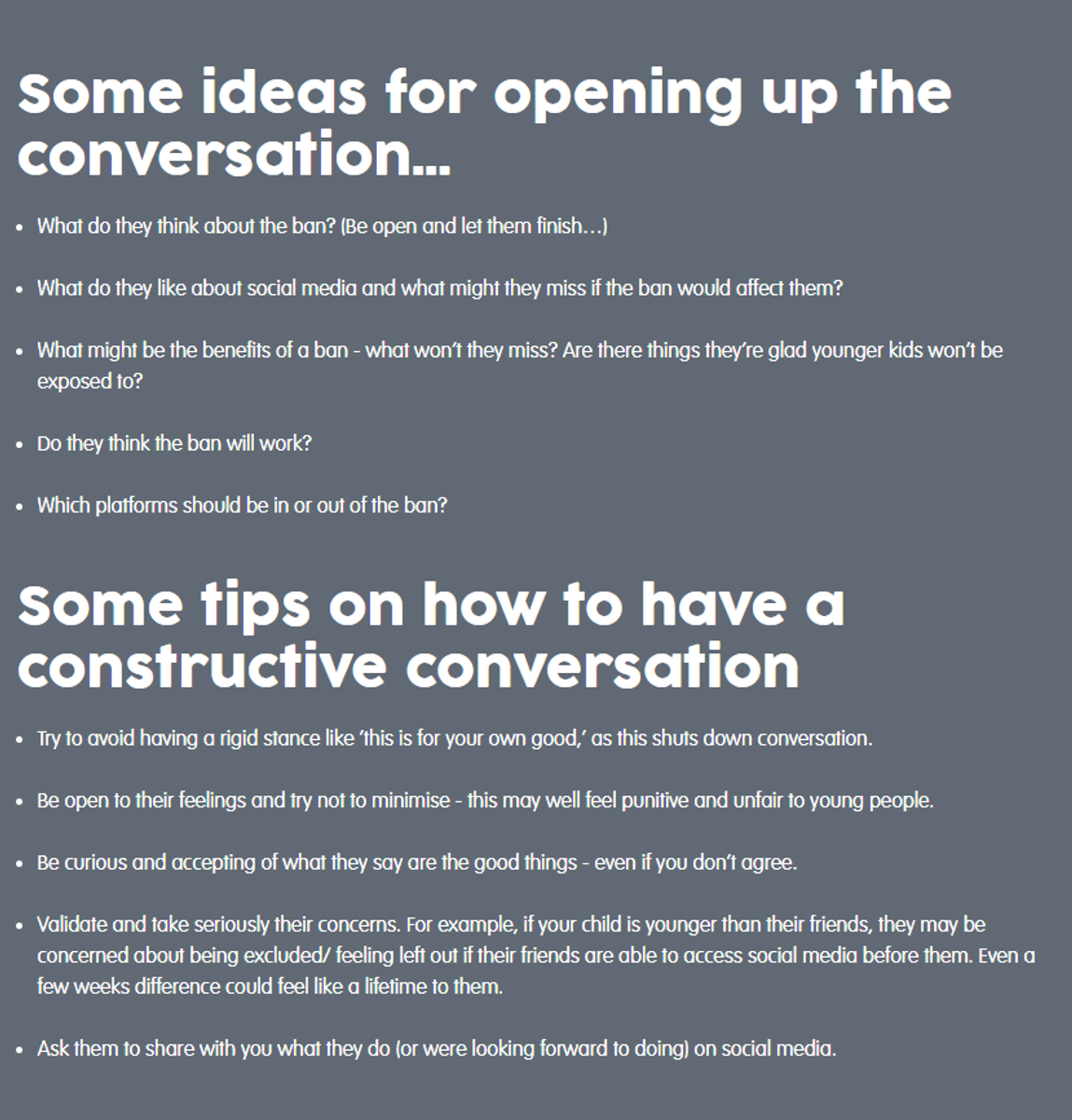Academic Care & Wellbeing
Social Media Age Restrictions

Academic Care & Wellbeing
Social Media Age Restrictions
Information Sources: eSafety Commissioner, Headspace: Information for family about the social media ban, eSafety Social Media Minimum Age Regulatory Guidance (v 16 Sep 2025)
The Australian Government is protecting young Australians at a critical stage of their development, through world-first social media age restrictions.
From 10 December 2025, age-restricted social media platforms will have to take reasonable steps to prevent Australians under the age of 16 from creating or keeping an account.
The restrictions aim to protect young Australians from pressures and risks that users can be exposed to while logged in to social media accounts. These come from design features that encourage them to spend more time on screens, while also serving up content that can harm their health and wellbeing.
While no formal assessments have been made, the age restrictions are likely to apply to Facebook, Instagram, Snapchat, TikTok, X (formerly Twitter) and YouTube, among other platforms.
More generally, age restrictions will apply to social media platforms that meet three specific conditions, unless they are excluded based on criteria set out in legislative rules made by the Minister for Communications in July 2025.
The conditions for age restriction are:
The sole purpose, or a significant purpose, of the service is to enable online social interaction between two or more end-users
The service allows end-users to link to, or interact with, some or all of the other end-users
The service allows end-users to post material on the service.
Online gaming and standalone messaging apps are among a number of types of services that have been excluded under the legislative rules. However, messaging services that have social-media style features which allow users to interact in other ways apart from messaging may be included in the age restrictions, as well as messaging features accessed through age-restricted social media accounts.


The eSafety Commissioner understands that young people are not all the same. They use a range of social media platforms in varying ways and with different exposure to risks of harm. However, the Australian Parliament voted for the restrictions for the good of all Australians under 16. The delay is similar to other age-based laws, such as restrictions on the sale of alcohol and cigarettes.
What if I give my parental/carer consent?
This won't make a difference. Parents (or other guardians) won't be able to give their consent for their young people to access social media before they are 16 years of age.


As the law will apply to all of them, parents and carers will no longer need to choose between allowing their under-16s to set up accounts on platforms that may negatively affect their health, or making sure they are not socially excluded. No under-16s have to feel like they’re ‘missing out’.
Details about how the age restrictions will operate and other relevant information will be developed throughout 2025. The eSafety Commissioner will provide answers to frequently asked questions on our FAQ page and throughout the eSafety website. The information will help Australians, including under-16s, parents, carers and educators understand and prepare for the change.
Headspacehave provided the following support and advice for Parents/Carers to have a conversation with their child about the upcoming age restrictions.


Throughout 2025 eSafety will provide webinars and publish new and updated resources for parents and carers to help them understand how the age restrictions will work.
We will also provide more guidance on how to have discussions about the age restrictions with under-16s and prepare them for change.
Meanwhile, you can find eSafety tips for parents and carers on managing parental controls and screen time, as well as how to start hard-to-have conversations.
In addition, eSafety will continue to provide education support and professional learning to schools and education sectors. New advice for educators will also be delivered through the National Online Safety Education Council, Trusted eSafety Providers Program and eSafety Champions Network.
You can also read more information about the Social Media Minimum Age law and how it fits into the Australian regulatory environment.